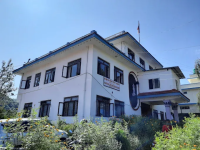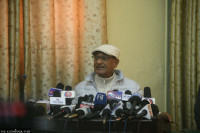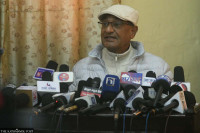National
Nepal Bar protests planned judge appointments amid hierarchy dispute
Says amended rule undermines lawyer-appointed judges.
Binod Ghimire
Nepal Bar Association has launched a series of protests against the Judicial Council as the latter prepares to appoint judges in various courts.
The umbrella body of lawyers, which has stood against the Judicial Council ever since an amendment to council’s regulations last year, has started fresh protests demanding reversal of the changes that alter the order of precedence among judges. The council had revised the regulations in September 2023, adjusting the ranking of judges. According to the amendment published in the Nepal Gazette on September 20 last year, the chief registrar of the Supreme Court, if appointed as high court judge, would be ranked right under the chief judge of the high court.
The association has termed the amendment as regressive, biased, discriminatory, arbitrary and unconstitutional, arguing that it contradicts principles established by the Supreme Court's verdicts.
In December last year, the council appointed Lal Bahadur Kunwar, the apex court chief registrar, as a high court judge and placed him in the second rank after the chief judge of Patan High Court. The association claims that the amended regulations unfairly demotes judges appointed from among lawyers, placing them below career judges in the hierarchy.
"The amendment to the regulations is unconstitutional. We had to start fresh protests because our demands have been largely ignored for months," Gopal Krishna Ghimire, chairperson of the association, told the Post. "Our protest will continue until the unconstitutional amendment is withdrawn."
The association staged a sit-in at the secretariat of the Judicial Council on Sunday. Starting Monday, district, high court, and special court chapters of the Nepal Bar Association will regularly stage similar protests at the respective courts, according to the association.
The lawyer's body started the protests as the council is making final preparations to appoint judges across three layers of courts including in the high courts. While four judges’ positions are vacant in the Supreme Court, 16 judges are needed in various high courts.
The five-member Judicial Council, led by the chief justice, nominates judges and justices. The council includes the law minister, the senior-most Supreme Court justice, and two advocates, one each picked by the Nepal Bar Association and the government.
As Chief Justice Bishowambhar Prasad Shrestha and Ram Prasad Shrestha, a council member representing the lawyer's association, are set to retire next month, the council is working to fill the vacant positions without delay.
The bar association, however, has said appointing judges without first scrapping the recent amendment to the regulations is unacceptable. "The Nepal Bar Association strongly demands that appointments to the Supreme Court and high courts be made only after revoking the amendment. Lawyers must be given respectful representation in these appointments," reads a statement issued by the association on Monday, adding that it would launch stern protests if its concerns are ignored.
In several instances in the past, it had been a practice to fill around half of the vacant judge positions from among lawyers. However, Chief Justice Shrestha has given them less priority, which is also a reason for the protest.
In January, 26 district court judges were promoted to high court positions. Four joint secretary-level officials under the judicial service were also picked as high court judges. But only nine lawyers were appointed as judges. The association had demanded that half of the judges be appointed from among the lawyers.
In the judicial hierarchy, those appointed to the high court from the lawyers’ category are ranked below those promoted from district court judges or picked from the judicial service.
"The protest aims to keep the council under pressure during the appointment process," a retired Supreme Court justice told the Post.




 18.12°C Kathmandu
18.12°C Kathmandu













%20(1).jpg&w=300&height=200)

